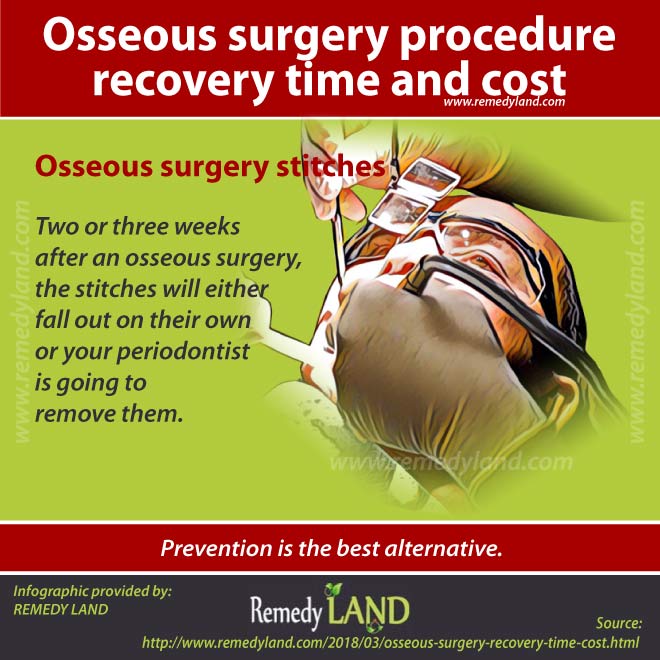Osseous surgery by definition is a dental procedure in which periodontist or oral surgeon removes and reshapes gum tissue and jaw bone affected by periodontal disease to a more ideal contour. Read on to learn more about the osseous gum surgery, is it painful, what is osseous surgery recovery time and cost.
Page Contents
Is osseous surgery really necessary?
Osseous gum surgery is the final and rarely needed step performed to heal the effects of periodontal disease when periodontal disease cannot be cured with antibiotics, root planing and root scaling. The best time for osseous surgery consideration is when gum pockets are too deep to clean and dental instruments have no longer effective. Periodontal osseous surgery is one of a few dental procedures that can help reverse periodontal problems.
Is osseous surgery painful?
Don’t worry, osseous surgery is done in the dental office and is not really as scary and overly invasive as it sounds, it’s really a pretty simple dental procedure. You will be awake during procedure and because it requires local anesthesia you won’t feel a thing.

What is an osseous surgery per quadrant?
Osseous surgery is done by quadrant of your mouth and depending on the position that is affected by the disease, periodontist may work on upper left and right or lower left or right quadrant. Length of osseous surgery depends on the number of quadrants to be worked on and on how big is the section that needs to be cleaned. It usually takes about an hour per quadrant.
How is an osseous surgery performed?
After the decision has been made to perform osseous surgery, you are probably going to be asked to sign an osseous surgery consent form. The osseous surgery includes numbing the area on which procedure is performed. After the onset of anesthesia, a periodontist will open up the gum tissue and fold it back and away from the teeth and underlying bone. This is going to allow a periodontist to gain access to the diseased root and bone area. Next step is trimming of infected gums and removal of disease causing bacterial deposits crusted on the teeth, roots and bone surrounding the root.
Osseous surgery bone graft
Don’t be scared if the situation requires a bone grafting. Sometimes advanced periodontal diseases can cause bone loss and bone grafting must be performed to replace and regenerate some of the bone responsible for holding your tooth in place. Traditionally in bone grafting, a piece of bone from another part of the jaw is harvested and transplanted into the jawbone. However, today this technique is replaced with bone grafting that uses processed bone from a cadaver source or an animal source.
These grafts, known as xenografts are just as successful as the patient’s own bone. They are used in most oral surgical offices today. The advantage of this method is in the fact that the procedure does not require a second surgical site. This works because your body is fooled and thinks that you have a broken bone that needs to be healed. Over time bone graft is resorbed and replaced with your own native bone. If periodontist suspects that your gums may grow down into the pocket he is going to place guided tissue regeneration membrane over bone grafting.
Osseous surgery ends when the gum is flapped to its original position and stitched in place.
Osseous surgery post-operative pain
After the surgery you may experience some swelling and pain, but everyone heals differently and there is a big chance that you will not have pain. You can use ice pack to fight swelling and for pain your doctor will prescribe pain medications and an antibacterial mouthwash or you can use salt water. Sometimes antibiotics are given to patient in order to prevent infections before, during, and after an osseous surgery.
What is the recovery time for osseous surgery?
Most people can return to normal life the day after surgery. After a week or two and again three to six months post-surgery, the patient must come back to periodontal office for follow up procedures or checkup of surgical area. Those visits and good oral hygiene are necessary to avoid post-operative infection especially during the initial phases of healing. The surgery was successful if you had healed properly and the disease did not return. After the surgery your teeth might be sensitive. This sensitive can be minimized with applications of fluoride or you can use toothpaste for sensitive teeth. In the beginning soft food is recommended, but you can eat and that’s the most important thing.
Osseous surgery stitches
Two or three weeks after an osseous surgery, the stitches will either fall out on their own or your periodontist is going to remove them.
Is there any an osseous surgery alternative?
Prevention is the best alternative. Also, there are some medications for periodontal diseases which are proven to be successful. And with some positive lifestyle changes such as better oral hygiene, quitting smoking and good nutritional diet, maybe you can stop further development of periodontal diseases. Root planning and scaling also can give positive results and with the removal of extra gum tissues with laser maybe you do not have to go under osseous surgery.
How much does osseous surgery cost?
The cost of an osseous surgery depends largely on the condition of your gums and underlying bones. Osseous surgery cost per quadrant can be anywhere from 500 to 2000 dollars. There is additional cost of diagnostic exam for around 400 dollars. If you have dental coverage find out what’s covered and how much of an osseous surgery cost is your responsibility.

